October 11, 2010, 0100 hrs, 22.01 S, 167.43 E, Log: 143,308 miles
Baro: 1015.5, Cabin Temp: 81 F cockpit 80 F, sea water 80.1 F
E winds 25-33 kts, 12′ breaking seas
Beam reaching at 7.8 kts with triple reefed main and genoa
ROUGH SEAS: SHIPWRECKS, MAN OVERBOARD & SEARCH AND RESCUE
Our Leg 7 joined us in Port Vila, the capital of Vanuatu on Monday, October 4 and since then we’ve had non-stop adventure.
We cleared the med-moor waterfront soon crew joined and headed for a sheltered anchorage behind the resort island of Iririki. After some snorkeling, serious orientation and teaching we set sail Tuesday afternoon for an overnighter bash to Erromango Island; 90 miles south of Port Vila. With headwinds to 22 kts and very rough seas we chose to motorsail the entire way arriving Wednesday morning 1000 hrs. It was all hands in the water for a swim to wash away the effects of seasickness before a late breakfast and nap. During navigation class we calculated that the tide should soon be high so we decided it best launch the RIB and make the most of the high water to cross the small the river bar entrance that provided a sheltered estuary for the village.
As we motored across the bar several men were waiting for us on the shore and when landed all of the men shook our hands and introduced us to Joseph, their chief. Joseph asked if we would like to see the sandalwood which the men were working on. Upon entering a small shed Joseph explained that a ship was due at 9pm and he introduced to Johnny, a sandalwood buyer who had flown in from Tanna the previous day. Johnny told us he was paying the equivalent of US$20 per kilo for cleaned sticks and logs of sandalwood. Judging by the piles of logs and stacked sacks of sticks there appeared to be a few thousands of dollars of sandalwood in the room. Joseph said that the islanders are planting more sandalwood trees which can be harvested in as little as 13 years.
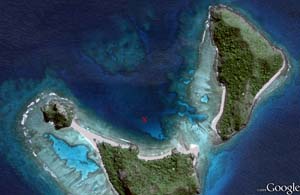 Johnny showing us that sandalwood the size baseball bat is about 1 kilo |
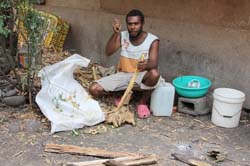 In preparation for weighing the lads clean up the sandalwood by chipping off the bark with machetes |
Erromango’s valuable sandalwood caused a violent and bloody past between 1840 and 1870 when sandalwood traders killed many locals, and locals killed and ate many traders and several missionaries. Chief Joseph asked if we would like to see the rock on which the villagers killed and ate the missionary John Williams. All nine of us gingerly filled the dinghy, motored across the river and hiked up to a large flat stone. Here, in 1839, the locals had chiseled the outline of Reverend Williams on the rock before eating him.
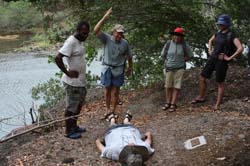 Jon testing out John Williams chopping rock |
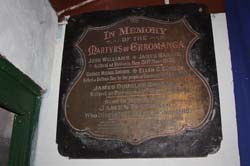 In preparation for weighing the lads clean up the sandalwood by chipping off the bark with machetes |
As we visited the small village church Joseph said, “We lived in darkness before. The missionaries brought light, and now we live in light and our lives are much better.” In fact, their lives seem quite good. We were introduced to the local nurse and his wife, shown their clinic and saw a lot of very happy people.
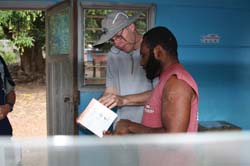 Jon chatting with the district nurse |
 The district nurse with his wife Priscilla and numba 1 pikinini Fransen |
Trying to avoid the daily strong afternoon winds we raised anchor at 0400 and set a course that hugged the lee of Erromango as far as possible, before heading south to Tanna Island, where we needed to clear customs and immigrations out of Vanuatu at Lenakel; the capital village situated on the SW side of the island. We had two options; either tack or motorsail into 20-25 kt headwinds to Port Resolution – an excellent anchorage on the SE of the island, then take a 2.5 hr truck ride to across the island to Lenakel or…sail closehauled on one tack to Lenakel. We chose the latter and had an excellent sail until we reached a point where the winds wrapped around the island and headed us. We’d read that Lenakel is a very rolly and exposed anchorage and as we approached the small village we wondered if we’d find any protection at all from the 25 kt winds and breaking surf.
As we approached the village of Lenakel we noticed two makers on the reef to leeward of the anchorage and concrete wharf. As the water was clear and anchorage area only 15′ deep we could see there many obstructions on the bottom. I asked for volunteer snorkelers to look for a clear spot to drop anchor and both Angelo and Amanda dove in with masks to discover that the bottom was covered with huge lava boulders with only very small patches of sand. They directed us to the clearest spot they could find, but just after we’d set the anchor they requested that we re-anchor as the chain had snagged a huge lava boulder. We then re-anchored to avoid an engine block with chain and a large ship’s anchor, also with chain snaking across the sea floor. If we were not careful our chain could quickly become caught under the lava boulders if the wind or current changed and we might not be able to raise the anchor without snorkeling down to free it. Amanda wanted to ensure we had both enough swinging and dragging room in case we needed to move in the dark.
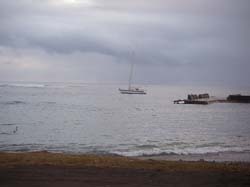 MT at anchor off the quay at Lenakal |
While waiting ashore for customs and immigration to return from lunch we learned that the main supply ship for Vanuatu’s southern islands had been tied to the concrete wharf with a broken main engine, waiting for an engine part to come from Vila. Two nights earlier, in order to allow the sandalwood ship to come onto the wharf she’d somehow moved to the anchorage where we were anchored.
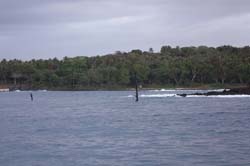 The mast of the shipwreck that we mistook for markers |
Just before sunset a 60 knot squall broke the anchor chain and the engineless ship ended up crashing along the rocky coast before sinking in 20′ of water. The crew had gotten off into a speedboat. The villagers seemed more concerned about all of the cargo and fuel drums that were still aboard than the loss of the ship but it helped explain the strange reef markers as on closer appearance they were the masts of the ship.
When on Erromango, Johnny, the sandalwood buyer had told us his family was involved in tourism and that his brother Eric could drive us to the top of the erupting Mt. Yasur volcano, located 1.5 hours away. Eric met us on the beach as we came ashore for customs, and agreed to meet us on the wharf at 3pm with his truck. I was surprised that he was there on the wharf early, smiling and ready to go!
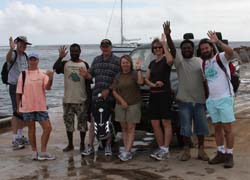 Leg 7 Crew ready to go volcano exploring – Jon, Amanda, guide Johnny, Jerry, Kathi, Kate, driver Eric and Angelo |
Jon Fawcett, 50
I am a liver transplant surgeon in Brisbane and have sailed, on and off, since childhood. Since moving to Australia in the mid-90’s I have moved up from dinghies to our current boat, a Cavalier 30. I have sailed from Chile to the Azores aboard Pelagic and my motivation for joining this expedition was to experience offshore sailing with my wife, Kate and to visit some of the remote islands of Vanuatu and look at opportunities to provide medical assistance there.
Kate Fawcett, 50
Kate is a London girl who moved to Brisbane, Australia a few years back. Besides working as a GP in a neighborhood clinic, she tutors med students at U of Qld.
Jerry Peterson, 55
Jerry grew up working on his family’s high mountain cattle ranch in Colorado, became a surveyor, studied religions and wrote a book for U of Ill while living in India for two years and has recently been tasked with managing all surveying and real estate for CA Dept. of Forestry & Fire Protection. It sounds like cruising will be a natural for him and Kathi.
Kathi Peterson, 55
I live in Auburn, CA and work with clinical research of medical devices. My husband Jerry and I would like to retire soon and do some ocean cruising. Since we haven’t experienced it yet, we thought this expedition was a good place to start.
Angelo Auguto Araujo, 41
I am a medical doctor (eye surgeon) from Aracaju, Brazil, and I have been sailing since January 2009. I am currently looking forward to buying a boat bigger than my 19 footer, and hope to one day do an offshore cruise.
Jon Fawcett’s account of Mt.Yasur – the smoking gun of the South Pacific
It would be remiss to visit Tanna and not pay a visit to the only active volcano in the South Pacific. Unless it rains, maybe – but more of that later. Five stalwart expeditioners, and Amanda, signed up for a tour with local guide, Eric. When Eric offered to throw in dinner as well, it meant Amanda didn’t have to cook on her birthday, it was game on.
The vulcaneers assembled at the quay at Lenakel looking for the assumed air-conditioned coach and there it was; a pickup with a row of seats, bolted to a removal plank, in the cargo tray outside! Three got the deluxe open air experience whilst three shared the inside back seat. The 2 hour, 45 mile trip each way along dirt tracks through grass hut villages was fascinating (cost-saving note to Toyota – no need for 3rd and 4th gears in supplying vehicles here).
Then the rain came, the drenching, old jungle war movies, sort. There might have been some murmurs of discontent from the outside travelers but it was difficult to hear because it was raining so hard. But it couldn’t be worse than going to windward in 25 knots, could it? Perhaps so as in order to make it up some of the steep hills Eric, had to reverse back up the narrow dirt road to get a bit of speed up before tackling the slopes. It was only after a couple of short stops that Amanda mentioned that perhaps the starter was not working for Eric either parked on a hill or kept the engine running. Oh, did I mention that co-guide Johnny’s job was to wipe the condensation off the cracked driver’s window.
Phew….We arrived! Scrambling up the desolate, black, lava field we were disconsolate. There was only a little smoke issuing from the crater. Maybe the rain had put out the volcano like a hiker douses a campfire with a kettle of water. Boom! There was a visible shockwave in the smoke and steam followed by a shower of molten lava thrown into the air as if a giant hand had casually slung a handful of burning coals in the air. And it wasn’t a one-off. Unpredictably, every few minutes there was another Yasur “roar and belch” reminding one of our group of fireworks night in childhood when there would be an erratic lighting of the Roman candles by a tipsy uncle between slurps of grog.
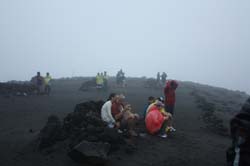 Wet, cold and foggy on top of Mt Yasur |
 A Yasur roar and belch of molten lava |
Worth the trip? Definitely, but look up and check the clouds before climbing aboard the Tanna taxi. Strangely enough on the return trip in order to make it up the hills Eric would turn off the car headlights. Oh. And the meal…was great, happy birthday, Amanda.
While crew were visiting the volcano I dinghied over the shipwreck. It was strange to look down into the clear water at the outline of the ship and I made a plan to snorkel down to photograph and explore it the morning but this was not to be as we made other plans. I’d been tracking the weather for a week looking for a suitable weather window for our passage to Noumea. After consulting with Bob Mc Davit from Met Service NZ he confirmed that high winds and seas caused by a squash zone were now forecasted for Monday night the 11th not Saturday as predicted earlier. Since we’d cleared out of Vanuatu before the weekend I decided it best to enjoy a few days in a quiet anchorage for teaching and visiting before putting to sea for Noumea. Jon & Kate had also been in contact with a small Seventh Day Adventist clinic in Port Resolution and had bought some medical supplies to give them, another good reason to reason to stay.
It was a calm but unnerving anchorage because of the crashing surf off Lenakel so I decided it best if we stood anchor watches and at first light at 0500 we departed for Port Resolution to again avoid the windy afternoons.
While in Lenakel we had heard that an overloaded local open boat making the rough 18 mile passage from tiny Aniwa Island to Tanna had overturned that afternoon and that three of the 12 people had swum back to Aniwa but the others were missing. Wow, this was the third disaster of the week! The day our crew joined we heard a VHF relay that a women was requesting help in searching for her husband who’d been lost overboard in rough conditions south of Malekula Island.
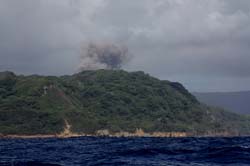 When we approached Port Resolution (named by Capt. Cook who anchored there in 1740) Mt. Yasur belched forth huge clouds of smoke and ash. |
At 0530 when a search and rescue plane from Noumea flew overhead we gathered from their VHF radio conversation that a search was underway for the missing boat passengers. Going around the southern tip of the Tanna wasn’t as rough as expected.
Once anchored in the calm waters of Port Resolution we heard five yachts, a P & O cruise ship, the Vanuatu patrol boat along with the French SAR plane coordinating the search for survivors on the VHF. When a dugout from shore came out and two villagers asked us if we had heard any news about the search Amanda suggested that perhaps we should offer help.
Then, minutes later over the VHF, we heard that Sea Level, one of the yachts, had spotted the overturned boat and had rescued one old man who was clinging to the hull. At that news we quickly got underway heading to the search area, 18 miles to windward. Further information trickled through over the radio and it became apparent that Steve May aboard the 41′ Corsair catamaran Endless Summer was in charge of the search. It was a credit to Steve that he had a search plan taking into account debris that had been spotted and sounded so collected. It sounded as if coordinating rescue operations could have been Steve’s previous job. I notified him that we had three doctors onboard and were heading to the search area as quickly as possible.
We sailed closehauled at 7.8 to 8.5 kts in 20-25 kt winds and large crossed seas and had covered the 18 miles to the search area while wondering how a small motorboat with 12 people could ever have set out, a sign of the desperate need they had to make the journey. We then heard that the plane had spotted two more survivors and that TeKoro, the Vanuatu patrol boat, could not get them onboard due to the patrol boat’s freeboard. They requested that Jim and Kent Milski aboard Sea Level, a 49′ custom Schionning catamaran with long sugar scoop transoms, rescue them. Sea Level was able to get the guys aboard and asked if it was possible to have one of our doctors join them. After some debating and giving of medical advice on how to care for the barely alive survivors we all decided that the seas were far too rough to transfer anyone at sea and that it was be best if we follow Sea Level back to Port Resolution.
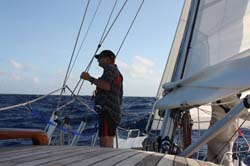 Jerry maintaining a vigilant search as we approach Aniwa |
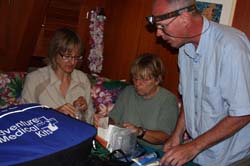 Kate, Kathi and Jon review our medical supplies as we return to Port Resoultion |
We arrived back in Port Resolution after dark, following the tracks on our Nobeltec electronic navigation system and our Raymarine/Navionics chart plotter into the very poorly charted, unlit, breaker-lined narrow passage. Thankfully Amanda also noted some key entrance waypoints from the GPS and depths and was able to relay these to Endless Summer who arrived later and only one engine working and had no functioning radar. When Jon, Kate, Kathi and I met Jim, his wife Kent and their friend Larry Mosher on Sea Level, they said they had just finished taking the survivors ashore where a doctor met them. He was then taking them on the two hour drive to the islands only hospital at Lenakel.
Jon Fawcett’s account of the rescue:
Aboard Sea Level we heard an incredible story from Jim Milski, who was still scratching his head in amazement as to how the rescue had been pulled off. That morning having just arrived from Fiji and not even cleared in he took on two village men, Nelson and Charlie who is the village witch doctor or magic man and set out upwind 2 hours for the designated search grid. Everyone had calculated that the 20-25 kt ESE winds must be setting a surface current to the WNW so the search began on the SE of the island downwind from the coast were the four people had swam ashore. After searching for a while Charlie took up a position at the windward shrouds and commenced chanting, eyes half-closed. After a while he declared that he had a vision of men swimming. Casting some leaves in the water and offering prayers, Charlie pointed southeast to the other side of the island. Jim, an existential surfer from way back, didn’t hesitate. He tacked Sea Level over and followed Charlie’s directions. An hour later, the upturned hull hove into view and minutes later they had the old man aboard the catamaran.
Debris was now being spotted and identified by the survivors; a woven frond basket of Aniwa oranges, blue jerry jugs and a yellow tarp. The explanation for the current anomaly was almost spooky. This was relayed to the French SAR aircraft who then quickly found the two men clinging to some floats 4 miles to the east of the boat. How the aircraft crew could spot two swimmers wearing dark t-shirts barely afloat is amazing. Jim and his wife Kent said the guys were very cold and nearly dead and that they had only just managed the get them aboard. Jim could find no pulse, but a short time later they drank water and opened their eyes – these islanders are tough.
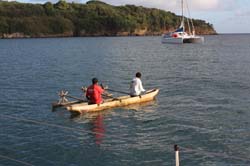 Charlie and Werry paddling across to Endless Summer |
At first light yesterday, 5am, Charlie and Werry paddled a dugout canoe out to our three yachts. Finding no one awake on Sea Level or Endless Summer they quietly paddled up to MT. They told us that a woman in the next village had a fishon (it took me awhile to understand that it was a vision, not a fish on they were talking about) that there were three people still swimming. Charlie asked if we would take them back to Aniwa to search for them. I said of course, and dinghied over to the two catamarans to wake them up and ask if they were up for another search. They both agreed, saying they expected this and that we should do everything we can to help. I met eight of the village elders and searchers ashore and distributed them among the boats. The woman who had the vision was not coming, but would be relaying her directions via cell phone. I asked if the guys had spare batteries for their phones, but none did.
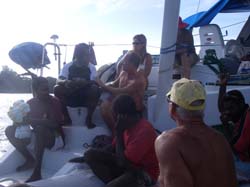 Aboard Sea Level a search plan is discussed |
As Sea Level was the largest vessel and had the best transoms for getting survivors back aboard, Jon and Kate, both doctors, went with them. Steve May was aboard Endless Summer were exhausted, having not even reached Vanuatu after a rough three day passage from Fiji before joining the search. We offered to loan them Kathi and Jerry, both excellent helmspeople. Johnson, the village nurse came with us and we were off, with Steve and Jim formulating a search plan based on where all of the wreckage and survivors had been spotted.
We spent the entire day searching in very rough conditions with Johnson, Amanda and I scanning for survivors or wreckage. Some of the old men had told Jim that there is an anti-clockwise current south of Aniwa that then sets north. Our GPS units confirmed this and the strange currents made the seas extremely confused in places. In late afternoon after no luck we jointly decided to head back to arrive at Port Resolution before dark. It was sad and depressing to have only spotted a blue jerry jug from the wreck and possibly the yellow tarp seen previously.
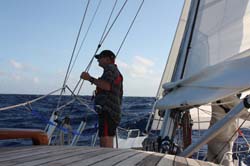 Johnson phoning in to see if there is any news |
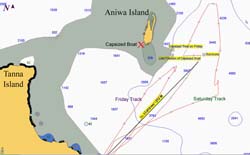 The Nobeltec chart showing the positions of the found overturned boat, survivors and our search tracks. |
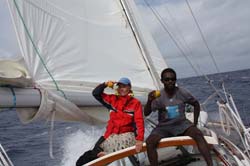 Amanda and Johnson enjoy an orange from a basket of renowned Aniwa oranges whilst continuing to search |
Jon’s account of his second day searching.
On Sea Level, Jim and Kent were gracious hosts to us and the two villagers aboard. The catamaran, a superbly homebuilt Schionning 49, performed impeccably (who says a modern cat can’t hack it upwind?) and a lot of sea was covered but sadly no further success ensued. As we reached back at 10 knots, there was somber reflection of an episode that sadly is all too common in this part of the world where life is noble but a harsher deal than it is for us. The final word should go to Jim when asked why he broke off from the search pattern set up by the authorities and went with Charlie. “That guy is part of this world and I’m telling you, he just knew. Beats any amount of science.”
 Mary, Mike, Bob and Angelo |
In the hopes of recovering from repeated bouts of seasickness Angelo had opted to stay ashore at the yacht club (a thatched hut with a view of the bay) for the day. He also had adventures in the treating and setting a boys arm that had been broken five days earlier. Mary and Mike off the catamaran Carpe Vida thankfully had the necessary medical supplies.
 |
The villagers thanked us sincerely that night and asked if Amanda and I would meet them ashore this morning at 7 before we had to (because of the impending strong winds) set sail for New Caledonia.
Ashore this morning we found all of the elders assembled on the yacht club grass. Werry, the yacht club manager and brother of Johnson thanked us on behalf of all the people saying they were sorry we couldn’t stay for the special time of thanks they had planned for the crew of the three yachts. They gave us baskets of fruit and fine woven baskets.
For further coverege, visit Lattitude 38 here.
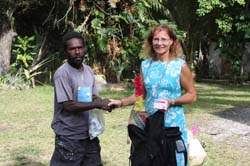 We gave Johnson the antibiotics and medical supplies that Kate and Jon had brought to donate to the clinic and mentioned that we looked forward to visiting next year under happier circumstances. |
 Saying farewell to Sea Level |
The GRIB files had forecasted winds to 35 knots with 20′ seas as a cold front and squash zone collide early Tuesday but it looks like the system has arrived a day early. Since leaving Port Reslotuion we’ve covered 120 miles while experiencing winds of 25 to 33 knots and fairly heavy short seas. We now have 30 miles until we pass the SE corner of Mare Island, one of the sparsely-populated Loyalty Islands belonging to New Caledonia. Once we pass the island we’ll be able to fall off 30 degrees to an easier broad reach for the remaining 60 miles to Havannah Passage, the start of the 45 mile series of channels leading to Noumea, the capital of New Caledonia.
October 14, 2010, 1300 hrs, 22.16 S, 166.25 E, Log: 143,391 miles
Baro: 1015.5, Cabin Temp: 81 F cockpit 80 F, sea water 77.6 F
Moored in Port Moselle Marina, Noumea, New Caledonia
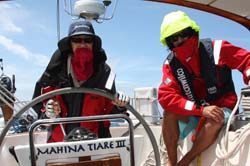 Kate and Angelo share a challenging watch |
We set a course to pass on the windward side of Mare Island, rounding it at first light. This allowed us to fall off onto a fast reach with winds gusting between 22 and 40 knots. Havannah Passage, the main channel leading 45 miles through reefs and islands to Noumea, has a nasty reputation for breakers and overfalls especially when a 5 knot ebb tide opposes the prevailing SE winds. After some apprehension we were pleased to find the US tide tables accurate as we started noting that we were picking up current. At first a half knot when about 12 miles out then a full knot as we neared the pass.
Concerned about potential breaking seas we requested that crew put on float vests and close all hatches, only to find the pass much calmer than the seas had been. We kept lots of sail up, reaching the entrance to Port Boise, a slightly protected anchorage six miles in from the pass, just before dark. It took us a couple tries to find the most protected anchorage with enough depth but before dark we had the anchor well set and in minutes we were all in the water and lined up for showers.
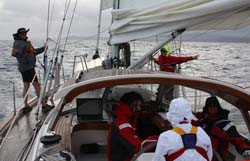 Enjoying the stiff afternoon breeze in the lee of the reef as we head to Port Boise |
We stood anchor watch all night and the following morning after a bit of a sleep in and leisurely breakfast our crew voted to sail the remaining 42 miles to Noumea that day rather than choose a better suited anchorage and catch up on teaching. What a sail we had with 26-40 knots from astern or the quarter, triple-reefed MT surfed along in the semi-protected water, pulling into Noumea around 16:30. Port Moselle Marina, where arriving boats are supposed to tie to clear customs, had no visitor’s berths available so we anchored across the harbor for another windy night. When listening to the yachts chatter on the VHF we learned that three days of high winds had kept everyone in port and as soon as the winds abated several yachts were heading to Australia or out cruising the extensive lagoon, claimed to be one of the worlds largest.
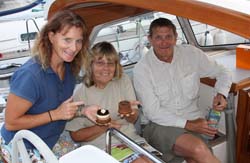 Later in the afternoon Kathi and Jerry returned with decadent chocolate treats and Kate had news of a French restaurant she’d discovered while on a walk around the historical Latin Quarter. Kate’s restaurant La Chaumièr (thatched cottage) was charming and exceptional and an enjoyable evening was had by all. |
I was ashore at the marina office when they opened Wednesday morning but still no berths were available. The helpful staff were telling everyone who came in the door or called over the radio to keep trying back later in the day but I asked if I could just wait in the office. “Certainly and here is all of the paperwork to fill out for quarantine, customs and immigration” was the reply. Not long after I started the paperwork a Kiwi skipper came in to say he was leaving within the hour. BINGO, we had a slip assignment and not long after I had the paperwork completed the marina manager said, “Your slip is empty, give us a call on Ch 16 just as you enter the marina and there will be a dock assistant to help you tie up”.
Meanwhile Amanda had completed sail design and construction, sail repair, rigging spares and cardinal buoyage system classes. I’d radioed Amanda to give her the berth info and minutes after I returned our eager crew had the anchor up, fenders tied and dock lines ready. Once in our slip we waited a short while for quarantine officer, followed by immigration. Interestingly, for the first time ever, both of the officials were local kanaks (the indigenous Melanesian people) not French. They were a little shy but very polite and charming. Once the formalities were completed crew headed ashore for showers, ATM’s, internet, laundry and to scope out a restaurant for dinner.
Thursday morning was a busy one, with classes on anchoring, electrical power systems, storm tactics and three-strand splicing, interspersed with packing and cleaning. The weather was perfect with clear warm sunny skies and crew left at noon eager to dump their bags at their hotels and set off exploring Noumea’s museums, beaches, café’s, gallery’s along with town’s quaint old quarters and parks.
